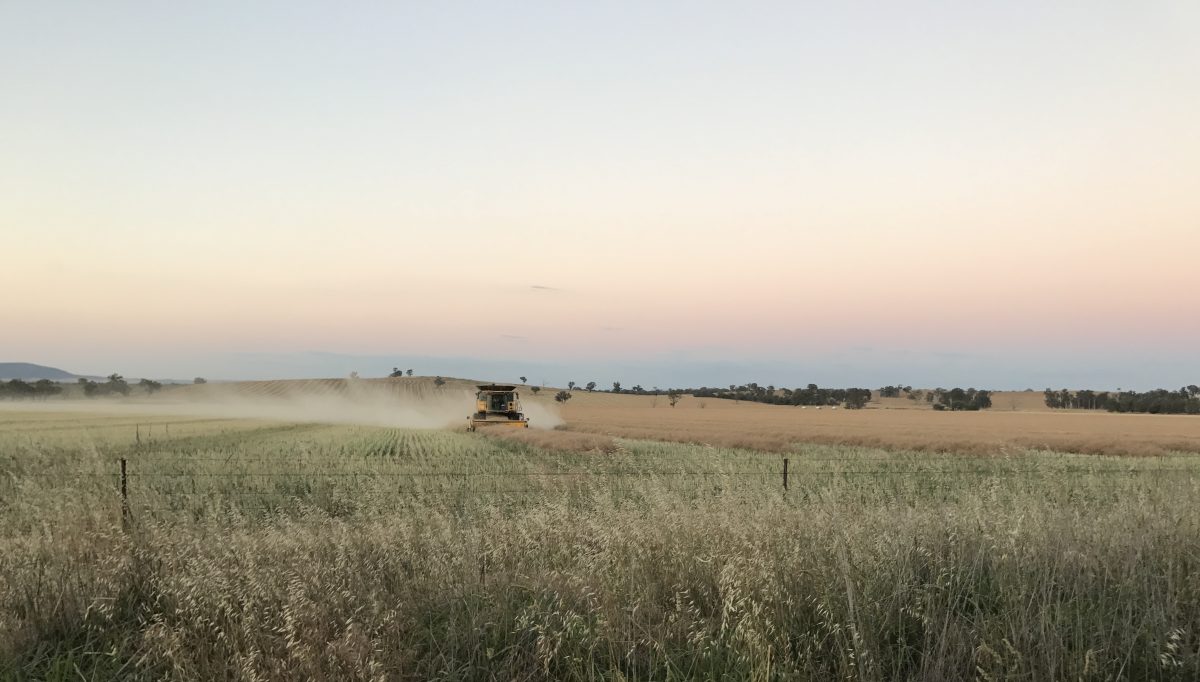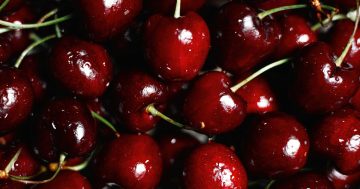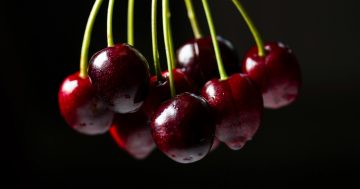
After receiving up to 200 mm or eight inches of rain within a week, South West Slopes farmers are now back in the thick of their crops trying to salvage what grain they can from this year’s harvest. Photo: Edwina Mason.
Paddocks across the state’s south are again bustling with activity as farmers and fruit producers scramble to salvage harvests disrupted by recent heavy rains.
The unseasonal weather which delivered between six and eight inches across the South West Slopes within eight days has brought mixed fortunes, with challenges threatening some crops but offering unexpected advantages for others.
For many grain farmers the rain has turned what was shaping up to be a fairly promising season into a logistical nightmare – as harvest halted for the two major rain events, farmers rushed to collect what they could in between and are now battling muddy conditions that add to costs and delays.
The prolonged moisture and humid conditions has led to sprouting in wheat and downgrading of grain quality, pushing yields destined for premium markets into feed-grade categories.
Local agronomist Andrew Daley said crops in the northern part of the region were looking reasonably good until the rain hit.
“The harvest was very postcode determined this year; once you go southwest of Cootamundra – that area had already dropped off very quickly,” he said.
“They didn’t get the big rain this year – only around 266 mm of rain prior to harvest, while anything north of that got around double that, so there was a lot of moisture stress in the more southern grain growing areas,” he said.
No matter their postcode, farmers had already come to terms with frost damage as mid-September temperatures across the South West Slopes plummeted way below zero.
That was predicted to have the most savage impact on 2024 yields of canola and wheat.
“Now, of course, as we get rolling on harvest, this rain comes in and now we’re seeing downgraded grain across the paddocks,” he said. “It’s frustrating”.
While grain farmers struggle, stone fruit and cherry growers in the cherry capital of Australia are walking a similar tightrope, though with a touch more optimism.
The rain has led to significant challenges, particularly for early-season cherries prone to splitting, as well as stone fruits like peaches and nectarines vulnerable to fungal infections.

The rain hasn’t dampened the spirits of cherrypickers who have visited Young in droves since the start of cherry season, taking advantage of the many farm gate “pick your own” experiences on offer. Photo: Ballinaclash.
Yet many growers see a silver lining in the moisture’s potential to boost the quality of late-season fruit.
Cath Mullany says the rain actually helped to size up the fruit – varieties such as Silvia, Regina and Sweet Georgia – beautifully.
“And it’s incredibly sweet,” she said. “If we can get some sunny days now, we’ll have a strong finish.”
The Mullany family orchard Ballinaclash is one of many near Young offering on-farm ‘pick your own’ experiences to people who travel to the area in their quest for cherries in November and December.
“That wasn’t a complete disaster for us all; we all kept on going.” she said. “And on the day we got four inches, which was last Saturday, we had so many people go through the orchard, they saw it as part of the experience and they just got out there and kept picking. The kids particularly absolutely loved it.”
While this weekend is Ballinaclash’s final in terms of pick your own fruit, Cath says boxes of cherries will still be available at their roadside shop alongside their stone fruit, which comes into season now, and other offerings – such as Cath’s delectable cherry pies – until Christmas.
“We encourage online bookings for picking to ensure a smooth experience,” Kathy added.
Fourth-generation cherry and plum producer Scott Coupland and his partner Daisy also sell fruit direct to customers under their own Australian Blue Bird brand.
He noted mixed results from the rain, with some varieties faring better than others.
“It’s been a little bit more work picking through the fruit, but the flavour this year is remarkable,” he said.
“And that’s the other thing people have been complaining about, is the heat, but that’s generally what we should be getting,” he said. “And as a result, the cherries have had a bit more sugar in them this year, they’ve actually been a bit sweeter.”
He expects his orchard’s cherry season to wrap up before Christmas, with an emphasis on supplying the local market.
“There’s still plenty of cherries you know, Lapins, Cordia, Regina, Sweetheart, Simone and Sylvia – there’s a whole range of different varieties people can try,” he said.
“Young’s still the cherry capital. We’ve had some challenges, but the fruit is sweet, and the community’s spirit is strong.”
Apricots, white and yellow peaches, white and yellow nectarines and plums are now also hitting the markets and are usually available around Young until early January.










